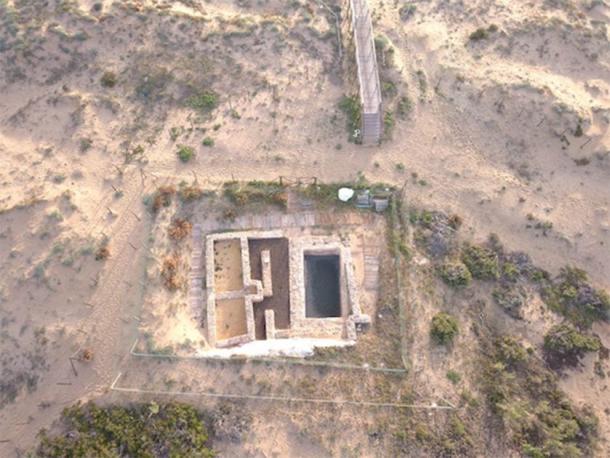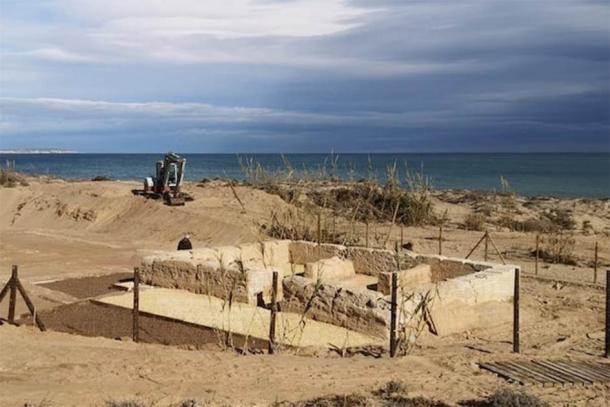Researchers in Spain have unearthed the foundations of a rustic Roman residential seaside villa at Guardamar, like none other ever discovered. Why is it so unique? Well, this one had the later addition of its very own Islamic tower and mosque!
Translated literally, “Guardamar” means “guardian of the sea.” Located at the mouth of the Segura River, in Alicante, Spain, the settlement gave ancient seafaring vessels the ability to penetrate the mainland easily. And this is the reason this area has hosted Iberians, Phoenicians, Greeks, Romans, and Arabs in various historical periods.
This strategic lookout point had had many ancient fortifications. However, the old walled city and castle were destroyed in an 1829 earthquake, which drove the surviving inhabitants closer to the shore, and this is how the Guardamar of today began its new life.
With the 2020 excavation season closed at Moncayo-Torre del Descargador archaeologists at this site have revealed a stunning new discovery: a Roman villa existed beneath an Islamic tower and mosque.

An aerial view of the Roman villa that was overtaken by the Muslim powers of Spain. The villa was then renovated to include an Islamic tower and a mosque. ( Universidad de Alicante )
The Islamic Tower Anchoring One Of Two Nuclei
El Moncayo Beach is a 1.25-mile (two-kilometer) long golden sand beach in Costa Blanca on the coast of Guardamar del Segura and about one hundred meters from the sea (depending on the tide). Since 2018 excavators have been digging into the foundations of two archaeological settlements in the area. Known collectively as Moncayo-Torre del Descargador : the “Moncayo” is a 2nd to 11th centuries AD settlement, and 984 feet (300 meters) away lies “Torre del Descargador,” a 10th and 11th century structure that is believed to have been used for storage and possibly surveillance for defensive purposes.
An article in R and I World says the two new discoveries were made by researchers from the Guardamar town council, the University of Alicante Research Institute for Archaeology and Historical Heritage (INAPH), and the Valencian government and the Provincial Coastal Service. It was while “consolidating, restoring and preserving” the extensive ancient environment along the coastal dune complex at Moncayo-Torre del Descargador that the researchers discovered the Roman and Islamic period structures .
The researchers say the two ancient “nuclei” were discovered some 984 feet (300 meters) apart: a fact which itself indicated to the researchers the presence of a more extensive archaeological site. The first site was unearthed at the Moncayo site where two phases of occupation of Roman were discovered dating to the 1st-4th and 5th-6th centuries AD, and the second was a late 10th to mid-11th century Roman building.
Architectural evidence suggests this Roman building was part of “a rustic villa with quadrangular rooms lined up along a wide corridor facing the sea, topped by two large absided rooms.” Former director of the Archaeological Museum of Guardamar (MAG), Sonia Gutiérrez Lloret, professor of archaeology at the University of Alicante said, “the large rooms with curved headrests are characteristic of 4th century villas, being used for representative and social functions such as the triclinium (room for banquets), and the tablinum (owner’s office), or sometimes the balnea, i.e., bathroom buildings, yet with no evidence of such use.”

Construction work to protect the area of La Torre del Descargador, on the eastern Spanish coast. ( Universidad de Alicante )
Conserved, Preserved And Ready For Tourists
The seaside Roman settlement was eventually abandoned and within the walls of one of its large rooms a Caliphate and Taifa period (11th century) mosque and a fortified Islamic tower were built, the foundations of which remain intact. Together, they are known as the “ Moncayo Mosque .”
Dr Gutiérrez said that while the foundations of the Roman villa , Islamic tower and small mosque have been identified little is yet known about the “nature and economic functionality, as well as the activities that took place there, such as agricultural, fishing, salting or salt production and transformation.”
These important new discoveries have now been consolidated and preserved and new interpretation panels have been installed at the sites to inform visitors about day-to-day life in ancient El Moncayo-Descargador.
Unfortunately, this has all been released in the same week that Spain hits 2.63 million Covid cases with a total of 56,800 deaths (at the time of this writing). I don’t suppose I’ll be jumping on a plane to the beaches of Spain anytime soon. Not even if the Roman villa, Islamic tower, and mosque were gold plated.
Top image: The Spanish beachside site of El Moncayo-Torre del Descargador, where the ancient Roman villa, and Islamic tower and mosque were discovered. Source: Universidad de Alicante
By Ashley Cowie
Related posts:
Views: 0
 RSS Feed
RSS Feed
















 January 28th, 2021
January 28th, 2021  Awake Goy
Awake Goy  Posted in
Posted in  Tags:
Tags: 
















